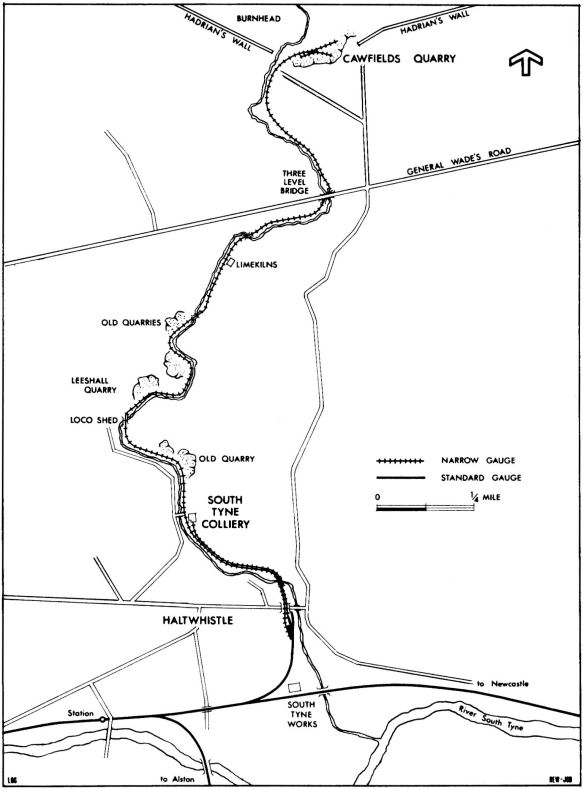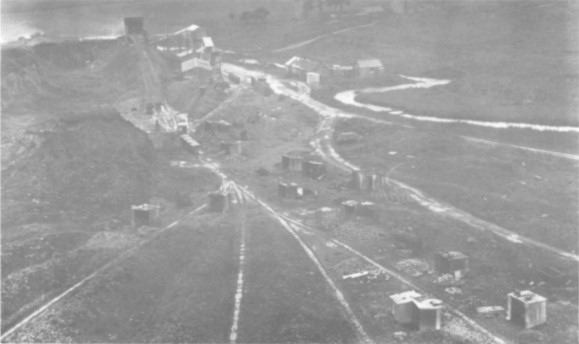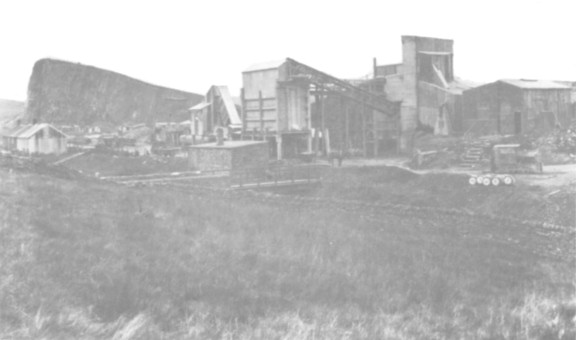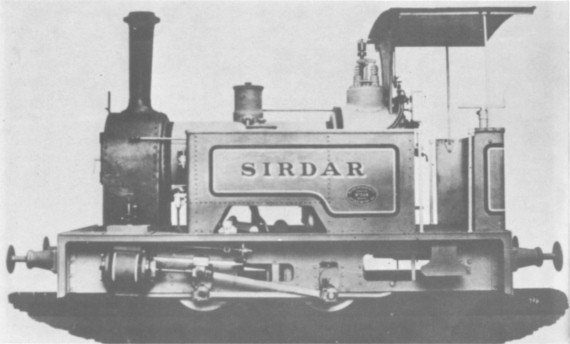
| THE INDUSTRIAL RAILWAY RECORD |
© FEBRUARY 1968 |
THE NEWCASTLE
GRANITE &
WHINSTONE COMPANY
L. G. CHARLTON
Situated just north of the Newcastle – Carlisle road which hereabouts runs almost parallel with the Roman Wall, Cawfields Quarry, north of Haltwhistle, has probably been producing stone from the time when the wall was built.
The Newcastle Granite & Whinstone Company started to work the quarry around 1902 and laid down a 1ft 11½in gauge single track tramway – alleged to have cost £3,000 – to Town Foot. A crushing and grading plant was operated at the quarry, and a roadstone tarring plant at Town Foot. The layout at the quarry is now indiscernible due to the use of road transport in later years. On leaving the quarry, the track swept in an easy curve to hug the bank of the Haltwhistle Burn which it crossed where both passed under the main road. For some distance the gradient was reasonable until the head of the ravine was reached, where it steepened considerably. It was made more difficult by the line following every twist and turn of the burn to the foot of the glen and South Tyne Colliery (which now produces drain pipes). The line then ran side by side with the colliery tramway in a large ‘S’ curve, crossing the burn once again to end in sidings and a loading dock.
The history of the three locomotives that have been used on the line is obscure. MOUNTAINEER was apparently the first of the scene and must have arrived about 1902 when the railway was laid down. An 0–4–0 saddle tank with 6in by 9in cylinders and 1ft 6in wheels, she appears in Bagnall’s list as built in 1896 for Hurst, Nelson & Co. Ltd., works number 1446. My correspondent at Haltwhistle stated that she had outside gear, and was built by Hurst Nelson so apparently she carried one of their works plates. Her normal load was twelve to fourteen tons. This is the locomotive mentioned by J. I .C. Boyd in his book on the Festiniog Railway (Volume 2, page 277) as having been offered to that company by a Birkenhead firm in the 1920’s and turned down as being too small.[*] The other steam loco, named VYRNWY, was a Kerr Stuart 0–4–0 side tank reported as having worked on the Lake Vyrnwy Waterworks Scheme. Further details I have not been able to discover[‡]. Her normal load was fifteen to twenty tons so she was obviously larger than MOUNTAINEER.
Both steam locomotives were laid aside by 1920 when the Company purchased a 40hp four cylinder 4–wheel petrol locomotive built by the Whitcomb Locomotive Works at Rochelle, Illinois (U.S.A.). This had seen service in France during the 1914-1918 War and came to Haltwhistle from a Tyneside shipyard where it had been used for hauling around keel plates. It had a massive frame and was heavily armour-plated which promptly earned it the nickname of "The Tank". The drive was by a two speed gearbox, through a reversing box and final chains. It was capable of hauling twice the load previously handled by either of the steam locomotives.

The locomotives ran five journeys a day, the last trip being to take the empties from the loading dock as far as the engine shed near the bottom of the wood. Next day six journeys were made. The time for the trip from the quarry and back was an hour and a half. The method of operation at the lower end of the line was interesting as the loading dock could only accommodate five wagons at a time. The engine always headed the train downhill and, when almost at the dock, the rear end of the train was sprigged down and the locomotive then took the first five wagons forward to the top of the incline. Here again the wheels were sprigged whilst the loco ran forward into a siding, the wagons then being allowed to gravitate down to the dock. After emptying, the wagons were drawn back and shunted into another siding, the remaining wagons then receiving the same treatment until the set was ready to return to the quarry. From the dock the stone was filled into railway company’s wagons which were handled for weighing and shunting by the South Tyne Colliery Company’s locomotive, for which service the colliery company charged threepence a ton.

View of quarry looking west from the top of the rock escarpment, October 1936. (Author)

The quarry and crushing plant as seen from the north, with petrol loco in right foreground, October 1936. (Author)

A "Sirdar" class locomotive, Kerr Stuart 704 of 1900. (Courtesy Hunslet Engine Co. Ltd.)
The Newcastle Granite & Whinstone Company went into liquidation in 1930; the Alston Limestone Co. Ltd. then took over the quarry, giving way in turn to the Mining & Quarry Engineering Co. Ltd., and finally the Amalgamated Roadstone Corporation Ltd. took over in 1946. The use of the railway had been discontinued about 1938 or 1939, when the tarring plant was moved to the quarry. Everything then went out by road transport. The quarry was finally closed in October 1952 after pressure from those interested in the preservation of the Roman Wall. The quarry itself is now a large deep pool reputed to hold some very large trout. A certain amount of very fine dressing still remains and is gradually being carted away. The spot where the line ran under the road has now disappeared as the level of the road has been raised to reduce steep hills on each side of the valley. From here the route down to Haltwhistle is a most enjoyable walk along the side of the burn and through the woods past the site of the colliery and a second engine shed down to where the tarring plant and dock lay beside the colliery screens and sidings. All signs of these structures have now disappeared with the building of a new road into Haltwhistle.
* According to Festiniog Railway records this locomotive was offered for sale on 16th October 1924 to Colonel Stephens at Tonbridge by Captain R. George Davison, rolling stock broker of Ellesmere Port, Cheshire. Stephens through it might be some use on the Festiniog Railway (of which he was Engineer), remarking that it "is an engine which, obviously, can be worked by one man, but it would be of no use for passenger traffic." However, the Festiniog was not in need of a locomotive at that time nor was it in favour of purchasing small steam locomotives for shunting purposes as the internal combustion type was preferred.
Davison described the locomotive as "24in gauge steam four wheels coupled saddle tank locomotive MOUNTAINEER, by Messrs. Hurst Nelson & Co. Ltd., cylinder 6in diameter, 9in stroke. Driving wheels 1ft 6in dia. Heating surface of tubes 79 sq ft, of firebox 9 sq ft. Total heating surface 88 sq ft. Working pressure 140 lbs per sq in. Bunker capacity 5 cu ft. Tank capacity 100 galls. Mountings include water gauge with glass protector, two test cocks, one steam blower, one pressure gauge, one blow-off cock, two injector steam valves, whistle and valve, two displacement lubricators fitted on steam chest. There are oil cups, siphons, etc where necessary. Weight about 5¼ tons in working order. Price £115 nett, F.O.B. Tyneside district. I understand this is a good little engine, which has been well looked after and recently supplied with several spare parts."
Bagnall records confirm most of the above figures, and quote the tube area as 80 sq ft, firebox 9.7 sq ft, water 104 galls, but give the gauge as 2ft 1in.
We are indebted for this information to the present general Manager of the Festiniog Railway, Mr A.G.W. Garraway. – Hon. Eds.
‡ The author has provided a faded photograph which, unfortunately, is not suitable for reproduction. However it shows that the locomotive was of a similar or even identical design to the "Sirdar" class illustrated. Kerr Stuart 748 of 1902 was also a "Sirdar" class .locomotive, with 6in by 10in cylinders, built new for Kirk Knight & Co., named VYRNWY, and delivered to Rainhill Station, Lancashire, for use on the construction of the pipeline from Lake Vyrnwy to Liverpool. It seems possible that this was the locomotive at Haltwhistle. – Hon. Eds.